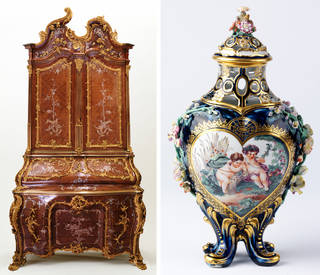Rococo, also known as Late Baroque, is an exceptionally ornate and dramatic style of architecture, art and decoration which combines asymmetry, scrolling curves, gilding, white and pastel colours, sculpted moulding, and trompe-l’œil frescoes to create surprise and the illusion of motion and drama. It is often described as the final expression of the Baroque movement.[1]
The Rococo style originated in France in the 1730s, and is particularly associated with the reign of King Louis XV (1715–1774).[2] It was developed by craftspeople and designers rather than architects, thus it is seen primarily in furniture, silver and ceramics. Rococo flourished in English design between 1740 and 1770, brought into the country by immigrant artists and craftspeople such as the Huguenot refugees from France.[3]
The term Rococo takes its name from the French word rocaille, meaning rock or broken shell, a natural motif that often appears in the designs, a principal feature of which is their curved asymmetric ornamentation, where the two halves of the piece do not match.[3]
In more recent times the term Rococo has also been applied to the visual arts, literary styles,[2] music, and even gardens, but with little clarity about precisely what it means in those contexts.[4]



